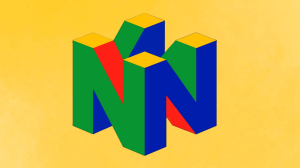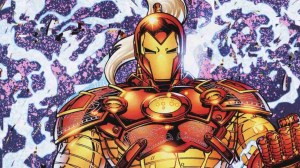When Season 16 of Overwatch 2 launches next week, it will bring with it what the development team considers the next core game mode of the title, Stadium. This mode was previously revealed in February’s huge update, and it offers users a wholly new experience than what the traditional game modes in Quick Play or Competitive do. Still a 5v5 mode, Stadium sees players pick their hero and stick with it in a Best-of-7 matchup, with quicker than normal battles on reworked maps that may could be over very quickly. The big wrinkle is the mods and powers players can purchase and equip, transforming their characters into the kind of hero that they want to play.
Videos by ComicBook.com
ComicBook had the chance to sit with Overwatch 2 Game Director Aaron Keller, along with Senior Game Designer Dylan Snyder and Lead Level Designer Ryan Smith, for a round table to learn more about Stadium and how they plan to keep it alive in Overwatch 2 for years to come.
Stadium Borrowed From Scrapped PVE (But Not All of It)
With Stadium, Overwatch 2 players will be able to upgrade their heroes in exciting and wild ways that are just not feasible in the traditional version of the game. These will include things like Reinhardt’s Firestrike ability leaving a trail of lava, firing multiple orbs at once as Moira, or turning into a rotating iceball as Mei when using cryo freeze. Keller confirmed that some of these abilities players will see did originate from the hero tree that was publicized for Overwatch 2‘s scrapped PVE game mode. Not all of the things players will find came from that specifically well though.
“Stadium, for most of its life, has always existed as a distinct mode within Overwatch,” Keller revealed. “We’ve been working on this for several years and most of the abilities that we’ve developed for it have grown over the course of that development. We have been able to look back on some of the abilities that we had in the PVE mode, and we still have a lot of people on the team that worked on that mode, but I think that really what we’re seeing now is the expertise that we’ve developed over the course of the last few years….The types of abilities you need for a PVP experience a lot of times are going to be different from the ones that work right in a PVE experience.”
RELATED: Marvel Rivals Success Is Forcing Overwatch Developers to Avoid “Playing it Safe”
Stadium’s Hero Pool Will Expand Each Season
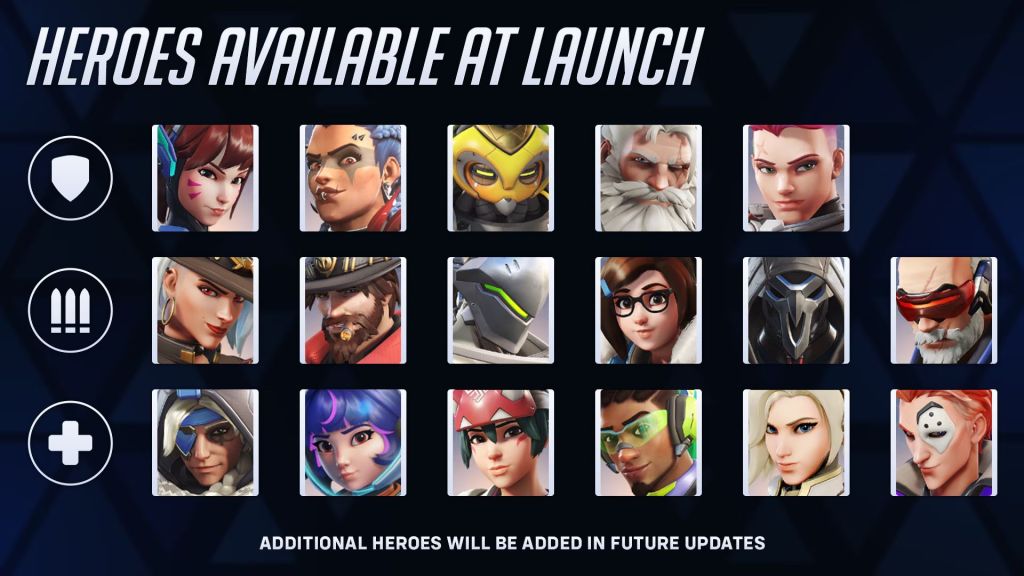
When Stadium launches it will come with a smaller selectable pool for players than the main Overwatch 2 game. Though there will be 43 playable heroes when Season 16 starts (with the official addition of Freja), Stadium will only have 17 heroes when it is released. Part of the reason the hero pool is cut in half is the sheer amount of information presented with the different builds and abilities for each hero. By cutting the amount of playable heroes down, Overwatch 2 can get players used to Stadium’s new interface and how it all works.
“Jumping into Overwatch now, there’s 40+ heroes available over the course of a match, that can be kind of a daunting experience for newer players. By restricting (Stadium) down to 17 it’s going to be a little bit easier for players to be able to like to pick up what is available over the course of a match.”
If your favorite hero isn’t in Stadium now, players may not have to wait too long to see them. Keller confirmed that “multiple heroes” will be added to Stadium with ever new season.
“We are launching a new hero in Season 16,” Keller added. “I think it would be cool to see (Freja) in Stadium sooner rather than later.”
Counter Swapping Is Off the Table (For Now)
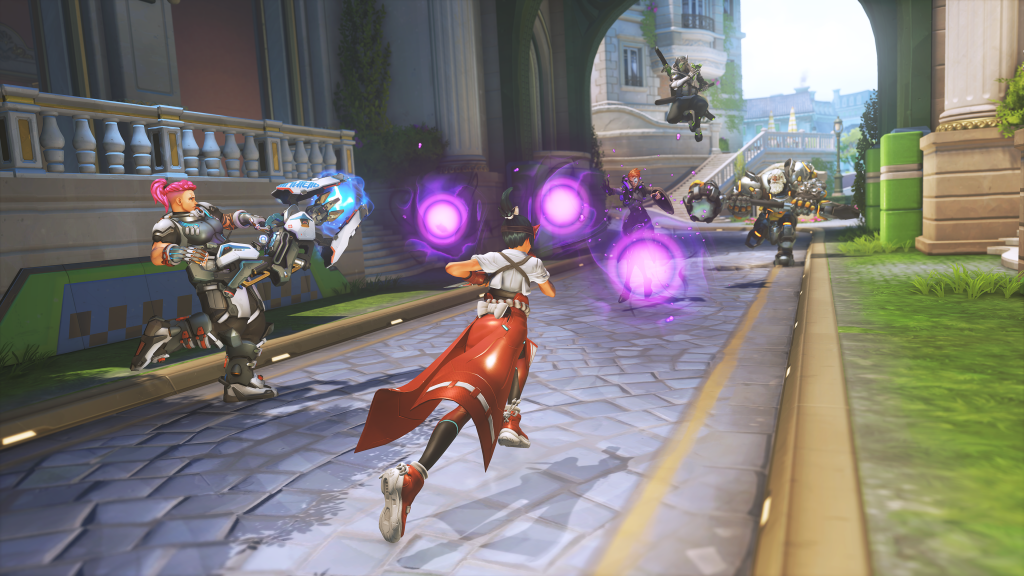
When a player picks their character at the start of a new Stadium game, they’re officially locked in to that choice for the duration. Though counter-swapping to answer the enemy team’s composition has long been a staple of Overwatch gameplay strategy, there’s a distinct difference in Stadium that makes this change not a be-all-end-all affair. Say for example you pick D.Va as the team’s one tank, only to find the enemy tank has selected Zarya. You might assume that you’re toast here, but the mods and powers at your disposal as you progress in the game can give you the chance to construct a version of D.Va that actually counters Zarya, not the other way around.
“The reason we don’t have hero swapping in the game mode is because we really want a team to be able to recognize what the enemy team is doing, and then be able to build to counter it,” Keller revealed. “A lot of Stadium takes place during combat and during the PvP phases. But it’s just as important to be able to put a strategy together around what you’re unlocking in the armory. And it becomes much, much harder to do that if you can’t predict what the heroes are going to be on the enemy team from round to round.”
Keller did admit that if “overwhelming feedback” about hero swapping in Stadium arrives, solutions have already been discussed about how it could be implemented.
“I don’t think we’re really ready to talk about what those are,” Keller said. “We’d prefer for people to be able to like, take it the way that it is, and play it with that intent.”
The Stadium Map Pool
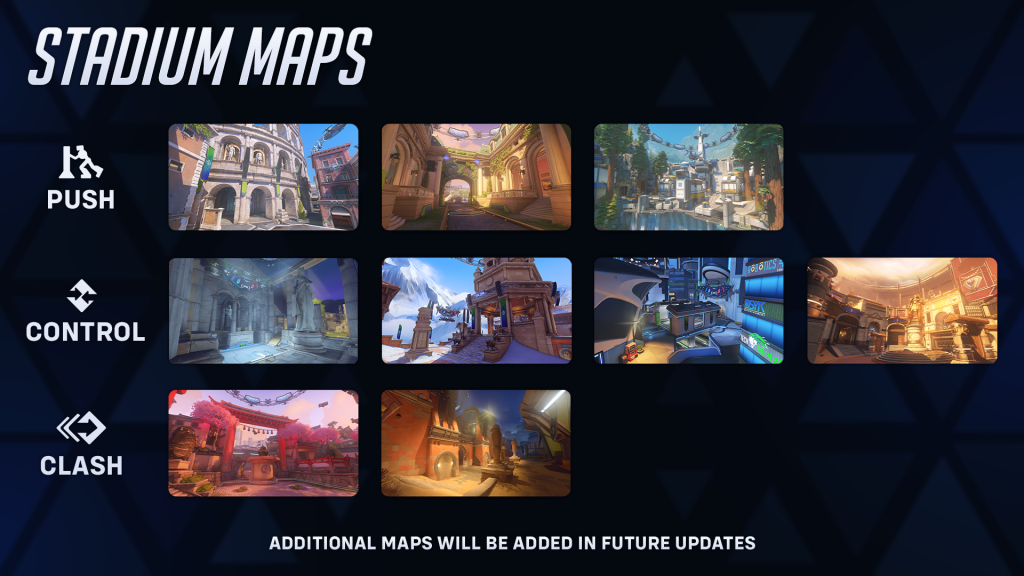
Stadium will arrive with just nine maps in its pool, and thanks to the seven round format there will always be a different arrangement and collective that you play. In addition this pool will only feature three types, Push, Clash, and Control, all of which have been condensed to make sure that the game rounds don’t last too long. Players will notice some familiar maps like Hanaoka and Throne of Anubis, Clash maps that have been sliced down from five points to three. There are also some reworked elements, like the classic 2CP Map Paris which is now back as a re-worked Push map.
Lead Level Designer Ryan Smith noted a lot of the reason behind where changes were made to existing maps was largely down to the runtimes of players getting from the Spawn room back into the action.
“We kind of magnified certain elements of these game modes, to make sure that players like experience like the most fun and balanced portions of those modes in Stadium,” Smith added. “So that was like a big kind of like pillar for us on the on the map and mode side.”
Keller noted that for the foreseeable future Stadium will continue to add maps into the rotation that are both brand new and also converted maps. Other changes to the map pool are also possible (such as removing maps on a seasonal basis), but currently there just aren’t enough available to commit to that.
“I think one of the things that we’ll be looking at is like how much are players responding to the new maps that we make and how much does that add to the mode versus how much complexity does it add to the mode to learn that new map,” Keller said. “And then how much does it add to the mode when we bring like a converted map from the rest of Overwatch? And if players are overwhelmingly looking at the new maps as the preferred way to play, we’d probably shift some of our resources to focus more on that. And we could potentially over time take out some of the converted maps, but it’s a little bit too early to say what the right direction to go there is.”
Alternate Game Modes in Overwatch 2 Will Still Happen
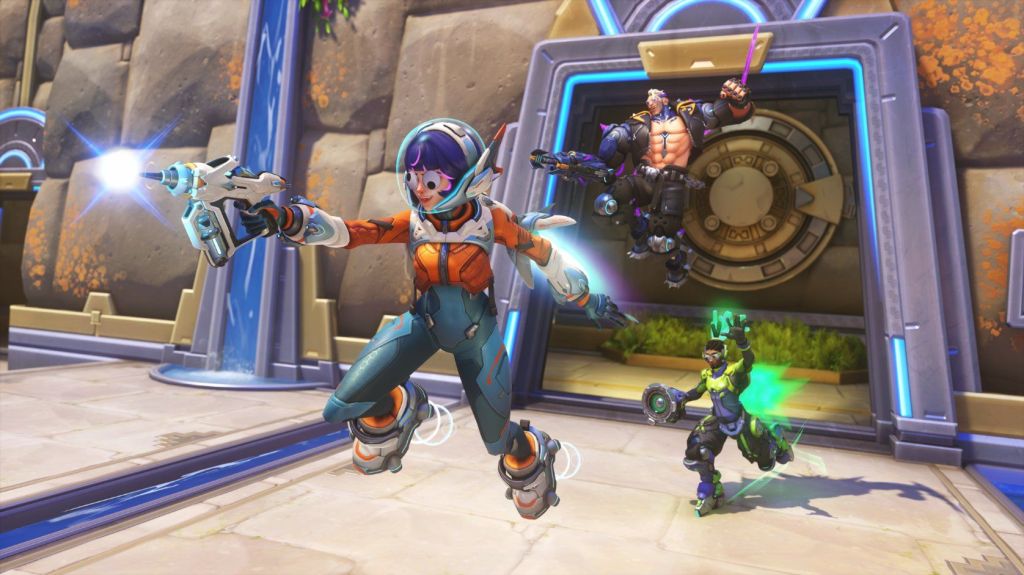
The Overwatch 2 team has made no secret that a lot of the experimental game modes they’ve rolled out over the past two years were secretly made as test beds for Stadium. Games like Mirrorwatch, Junkenstein’s Laboratory, and even the April Fools event all fed into Stadium and how they collected data on hero capabilities. Keller confirmed that even with Stadium not officially becoming part of the game itself, Overwatch 2 will still release these alternate game modes.
“We still will be building modes like that. In fact, we just kind of wrapped running our April Fool’s game mode, which probably does some of the weirdest, craziest stuff that we do in Overwatch,” Keller said. “I think in the future, you’ll see us continue to do experiments that that will hit at player customization and player powers. But you’ll probably see some experiments that don’t have anything to do with it, that are us looking for what we can do in the future, either for Stadium or for the rest of the game.”
Overwatch 2 Hero Balance in Stadium
Aaron Keller confirmed that hero balance is the thing that Overwatch 2 players give the most feedback about to the development team. It’s naturally something they talk about a lot, and Stadium will bring that to another level. When Season 16 of Overwatch 2 arrives and the game not only offers unique playstyles in 5v5, 6v6, and now Stadium, it may appear like a daunting task to maintain viability and balance across these elements. Blizzard is ready though and they’ve been building toward this for years.
“Sometimes the more systems you add to to a game or to a game mode, the easier it can be to balance across the entire experience,” Keller revealed.
He added that the addition of Perks to Season 15 of Overwatch, the game now has “multiple knobs to turn on an individual hero to balance them.” This ranges of course from health pools and damage output to things like balance with their individual perks. With Stadium these adjustments could come from things like currency that players earn, or even how specific heroes earn currency.
“There are so many different aspects of (Stadium) that we can now tune either for the whole mode or or for specific heroes,” Keller said. “I think that from the outside it probably looks like this is like a really daunting thing to do but I think for us having having a lot of these systems be separate from the main game is going to allow us to independently tune stadium and keep it in a balanced state while we can independently tune the core game and keep that in a balanced state.”
Overwatch 2 Season 16 will launch, with Stadium, on Tuesday, April 22.


